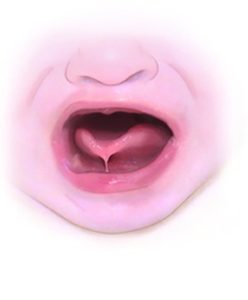As soon as Coby, my second baby, was born my midwife and I noticed a significant tongue tie (TT). It was visible because he coudnt fully raise his tongue to the roof of his mouth, or reach his lips when he cried.
Over the next few days, breastfeeding became increasingly more painful and despite seeming to feed well as he fed for a while and settled to sleep after, he lost weight.

Tongue-tie is something I had heard of, but I didn’t fully appreciate the impact it can have on breastfeeding. For many women it can be so painful and distressing that they have no choice but to abandon breastfeeding entirely.
I have enlisted the help of Vanessa Christie to write this article. Vanessa is a lactation consultant and author of “The baby feeding book”, out in Feb 2020. She is here to help explain what tongue-tie is and how to manage it!
What is it?
A tongue-tie is where the stringy bit of tissue linking the underside of the tongue to the floor of the mouth, is particularly short or tight and restricts the mobility of the tongue.

Assessing for a tongue-tie is not currently part of a routine newborn check in the UK. It is often surprising to parents, but most healthcare professionals, such as midwives, health visitors, GPs and paediatricians don’t receieve specific training on tongue-tie assessment and diagnosis; This leads to both over and under diagnosis.
Does it always affect feeding?
Having a good range of motion in the tongue is essential for breastfeeding to be effective, so if this is affected it’s very likely that feeding will be an issue.
When tongue tie is present, it can lead to other possible problems (although it is also important to rule out other explanations). This is because the inability to move the tongue freely can result in the milk getting backed up or being transferred inefficiently, and increases the work baby has to do when breastfeeding.
These associated problems may include:
- Reduced milk supply
- Sore/ cracked nipples
- Engorgement
- Mastitis
- Blocked ducts
- Short or very long feeds
- Frequently coming on and off the breast (or bottle) during a feed
- Large sucking blisters on the lips
- Excessive early weight loss
- Slow weight gain
- Difficulty controlling the milk flow.
What is the management?
If you suspect a TT it needs to be assessed by a certified tongue-tie practitioner who may advise a ‘frenulotomy’ if they confirm it.
This is a very quick snip to release the tie. In young babies it is done without an anaesthetic, which would introduce unnecessary additional risk.
Division of TTs in young babies is offered on the NHS in most areas of the UK although waiting lists vary. Private tongue-tie services are also available.
Should a Tongue-Tie always be dividued?
A true TT does generally cause problems so dividing it can make all the difference between a happy time breastfeeding and a miserable one.
However, it’s really important to get some good support first on how to best position your baby for a feed as tweaking this COULD be all that’s needed if the TT is not particularly significant.
Bodywork practitioners, such as cranial osteopaths and chiropractors also find that possible structural tension in a young baby can sometimes inhibit how freely the tongue moves and thus mimic a tongue-tie. In these cases, parents have found that breastfeeding symptoms are greatly improved with bodywork therapy and a tongue-tie division is averted.
Practical ways to feed with Tongue-tie
You may be awaiting an appoitment for frenulotomy, or your baby may have a tongue tie that doesnt necessarily need to be divided. Either way you may need some extra help to continue breastfeeding even with the tongue-tie.
Here are some top tips:
- Always aim for the deepest latch possible to minimise your pain and maximise how much milk your baby can drink.
- Feeding in a laid-back position can help with this.
- Massaging and compressing the breast during a feed can also help the baby to drink as much as possible by softening the tissue and making it easier for the baby to latch.
- If the pain is too much to handle or your baby is really struggling to stay latched-on, using a thin silicone nipple shield can temporarily help (but won’t solve the cause!) until you can get it divided.
- Depending on the situation, some mums also express to help increase their supply and to help soften the breasts.
- If you have developed cracked or sore nipples, these products can help with wound healing:
Additional Reading:
For us, we were lucky to be able to resolve the tongue tie relatively quickly. We were referred on the NHS for the tongue tie division, but I know that I wouldn’t have been able to continue breastfeeding if I had to wait the 4-6 weeks for the appointment. Instead we had it divided privately at day 3, and it made a huge difference within a few days!
To find a local private tongue tie practitioner, check this list, which is the same link provided to us by our NHS midwife before leaving hospital.
